Nerine bowdenii



Stemless / Acaulescent
A plant that has no stems, when the flower stalks and leaf blades are produced from ground level.
Clumping
A plant that when multiplies forms a clump.This clump forming bulberous perennial has lax dark green strap-like deciduous leaves. It has upright stems that are topped with clusters of pink or red frilled funnel-shaped flowers that appear with the foliage during autumn before dormancy.
Nerine bowdenii W.Watson, is naturally found from the Eastern Cape to KwaZulu-Natal in South Africa. It grows in a temperate region on mountain rock ledges, grassy hillsides and in scree appearing from almost sea level to an elevation of 1,500 m (4,921 ft). It prefers a well drained poor to moderately fertile moist sandy-stony to loamy or chalky soil that is acidic to alkaline with a pH range from 6.5 to 8.5. In warm regions it grows in a semi shaded position with protection from hot afternoon sun and in cooler regions it prefers an open sunny position. It is drought and frost-cold tolerant with a preferred minimum winter temperature of -10ºC (14ºF).
The Pink Spider Lily is grown for its pinkish flowers and its clumping growth habit. It is planted in small or cottage gardens along herbaceous borders or in group plantings in beds for parks and large gardens. It is also used in drifts under trees or in rockeries and the flowers are cut for floral arrangements. It has a moderate growth rate establishing in 2-4 years from division and should be left undisturbed for over 5-years. It can also be cultivated in pots, tubs and planter boxes requiring reliable moist soil. Once established it has a medium water requirement, (Scale: 2-drops from 3) preferring to have reliable moist organic rich soil for optimum growth and dislikes dry or hot conditions.
I.D. 367
UK hardiness zone H5
Climate zones H1, 5, 6, 8, 9, 13 - 24
USDA Zone 8-11
Nerine (nay-REE-nay) bowdenii (bow-den-ee-eye)
Etymology
Genus: - Nerine – named after Nerine, a guardian sea nymph sent by the Roman goddess Venus to rescue Vasco da Gama's armada en route to India.
Species: bowdenii – named after Mr Athelston Bowden (1871–1942) who was the Surveyor-General of the Cape Colony
Cultivar
'Alba'
This bulberous perennial is similar to the species but produces pure white flowers on a long scape during autumn.
'Pink Triumph'
This plant has silvery pink flowers that appear on a long scape with up to 10 scarlet blooms.

South Africa (Eastern Cape, KwaZulu-Natal)
Amaryllidaceae (AM-ar-ee-LEE-da-AY-see-ee)
These plants have a perennial bulb with basal leaves and flowers that occur in umbels.
Distribution
This family of plants range from wet to dry environments.
Diagnostic Features
These plants have a bulb from which strap like leaves arise.
The flowers are symmetrical, bisexual and occur in umbles on unbranched peduncles that have large bracts at the base. The perianth segments are unfused, large and showy with some species having a corona arising as a result of the linked filaments.
There are six stamens and the ovary is inferior that consists of three carpels with 1 to 3 chambers each consisting of numerous ovules. They have an unbranched style that has three short lobes.
The fruit is either a capsule or berry and the numerous seeds contain an endosperm.
Note:
There are many showy and common species in this family.
This plant tolerates between USDA zones 8a to 11a and grows to 0.5 m (18 in)
Fahrenheit 10º to 45º F
These temperatures represent the lowest average.
Celsius -9.5º to 7.2º C

Attention
This plant was last revised on the 08/05/2024
All photographs and data are covered by copyright. Apart from any fair dealing for the purpose of private study, research, reference or review, as permitted under the Copyright Act, no part including images and text may be reproduced by any means without written permission. The information presented in the map is only indicative and may contain errors and omissions. All inquiries should be addressed to sales@plantfile.com attention Peter Kirkland.

Simple
The leaf that is not divided.
Linear
Margins are parallel and length is ten times its breadth.
Basal
When the leaves grow from the base of the plant or radically from the root-shoot point.
Entire
A leaf margin with no irregularities (smooth).
Funnelform
A flower where the petals form a funnel shape.
Umbel
When the pedicels arise from the same point on the peduncle.| Jan | Feb | Mar | Apr | May | Jun |
| Jul | Aug | Sep | Oct | Nov | Dec |
The 80 mm (3 1/8 in) wide crimson to white funnelform flowers have ribbed petals that are reflexed with undulating margins and the protruding stamens are up to 40 mm (1 5/8 in) long. There are up to 12 flowers arranged in a terminal umbel that is held above the foliage on a tall scape and appear during autumn.
Note:
The species is pink but now there are many hybrids with a broad colour range.

Capsule
A dried dehiscent fruit, with an enclosing membrane normally containing may seeds."| Jan | Feb | Mar | Apr | May | Jun |
| Jul | Aug | Sep | Oct | Nov | Dec |
The 12 mm (½ in) wide rounded green capsule is arranged in groups of 3 and contains numerous small seeds. The small seeds are viable but the plant is commonly reproduced vegetatively to maintain true to type.
Note; All parts of the plant are regarded as mildly toxic if ingested.

The Pink Spider Lily is grown for its pinkish flowers and its clumping growth habit. It is planted in small or cottage gardens along herbaceous borders or in group plantings in beds for parks and large gardens. It is also used in drifts under trees or in rockeries and the flowers are cut for floral arrangements. It has a moderate growth rate establishing in 2-4 years from division and should be left undisturbed for over 5-years. Once established it has a medium water requirement preferring to have reliable moist organic rich soil for optimum growth and dislikes dry or hot conditions.
Divide offsets from bulbs from established plants. Replant the bulbs from mid to late summer 20-40 mm (1? in) deep with the neck well above the soil level and space 80-150mm (6 in) apart. Leave the bulbs undisturbed for 4-5 years or more.
Bulbs, Tubers and Corms (General)
This is an underground organ with a short fleshy stem and a flower primordium that is enclosed by fleshy scales. The structure of this monocotyledon is designed for food storage and reproduction.
Tunicate Bulbs daffodils, tulip, onion
These bulbs have a dry outer layer that protects the fleshy concentric inner scales as in an onion forming a solid appearance.
Nontunicate Bulbs lilies
These bulbs have no protective dry outer layer and are easily damaged. The scales are separate and are attached to the basil plate so care should be taken to keep them moist, as drying is detrimental to their health. Roots appear from the base and in some cases from the stem, normally growing during mid summer to autumn.
Offsets or Bulblets
This type of propagation is used on many bulbs which are normally removed when the bulbs are lifted then planted as separate plants. Some plants require a few years to produce offsets and they can remain on the plant undisturbed for many seasons.
Tulip produces offsets which should be lifted when the foliage dies off and daffodil forms offsets (split) over several years. These offsets may be stored or planted up directly.
Lilies increase slowly but the bulb in some species may be split and the scales produce bulblets as with other lily species bulblets are produced at the base.
Stem Cuttings
Lily species may be grown from stem cuttings where bulblets form at the base of the stem or leaf-bud cuttings with a single leaf and an old stem heal, the bulblets will form in the axil of the leaf.
Basal Cuttage
This method includes 'scooping' and 'scoring' on larger bulbs 170 mm (6 ¾ in) diameter. Scooping is carried out with a curved blade removing the basal plate of the bulb. Adventitious bulblets develop on the exposed scales.
The scoring method involves three cuts through the basal plate of the bulb, which produces bulblets in the axils of the scales.
In both of these methods the bulbs are planted out for one to two seasons where the mother bulb disintegrates and the bulbils multiply then grow.
Leaf Cuttings
This method is used for blood lily, hyacinth and other species. Well-developed leaves are cut from the base, then cut into sections and planted in a rooting medium 30 mm (1 1/8 in) deep. In a few weeks bulbils will develop at the base of the leaf. These are then potted up and grown on.
Bulb Cuttings
Narcissus, Hippeastrum, Cooperia and many other species may be propagated in this method.
The mature bulb is cut into eight to ten sections each containing a part of the basal plate. These are planted in a rooting medium vertically as to just show the tip and maintained in a warm environment. Bulbils will form at the basal plate with in a few weeks. After developing the bulbils are potted up.
Corm
The corm is a swollen base that is covered in a protective tunic, which prevents drying out. It is composed of scale like leaves that have nodes and internodes where axillary buds develop. There are two types of roots, fleshy contractile from the new corms and fibrous from the base of the mother corm.
After the foliage dies off the corm is lifted then allowed to stand after which old corms, new corms and cormels are separated.
The cormels are stored during winter and planted during spring after soaking in water for 2 to 3 days. These may be planted into containers or in a prepared bed and allowed to grow on for one season.
The corm may also be divided by cutting it into sections, which develop into new corms.
Tubers
This is a swollen underground stem that acts as a food storage organ with nodes and small buds as in the potato. Tubers may be propagated by either cutting the tuber in to pieces that contain buds (eyes) with sufficient stored food for growth or planted as a complete tuber.
Tuberous Roots and Stems
These tuber roots differ in that there are no nodes or internodes and the buds are only produced at the crown with fibrous roots at the opposite end. The tuberous stems have a vertical orientation and arise from the first nodes as in Cyclamen species.
One or more bud is produced at the top of the crown and may be propagated by dividing the tuber so that it contains a shoot bud. Each section should be dried for a few days and stored in sawdust or vermiculite to avoid shrivelling.
In a warm humid environment the tubers will shoot.
Rhizomes
A rhizome is a stem that grows horizontally either below or on the surface of the soil with the shoots growing vertically as in bamboo and many grasses. The stems are composed of nodes and inter nodes giving it a segmented appearance.
Propagation is normally carried out by division during spring and autumn, by cutting the rhizome into sections each with at least one node. Placed on a moist bed or slightly buried and kept them warm which will produce roots, shoots from the nodes.
Pseudobulbs
This is a large fleshy section of the stem that may have one or several nodes. They are produced on orchids and may vary depending on the species. They are propagated from offsets, which develop at the nodes or by division of the rhizome containing pseudobulbs during the dormant period.
PEST
NAME
Slugs and Snails
Various Snails Species
Description of the Pest
Slugs and snails are land molluscs. Snails produce an external spiral shell; slugs do not. The common garden snail Helix asperasa, grows up to 25 mm, long. Its body is slimy, broad, elongated and greyish, with two pairs of reticulated tentacles, with eyes at the ends of the longer pair. The mouth parts of snails and slugs contain a file-like organ known as the radula, which is used to rasp away at the host plant's tissue. Movement of the animal is by a muscular sliding movement, along a slippery trail of mucous; this solidifies on exposure to the air (typically described as a "silvery trail").
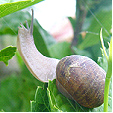
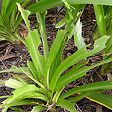
Appearance and Distribution of the Pest
Slugs and snails occur world-wide. Slugs tend to be more prevalent in heavier soil types.
Life Cycle
These insects have a Hemimetabolous life cycle, ie. When the immature nymphs resemble the adults.
Snail eggs are laid in moist soil, 20-40mm deep; eggs are white, spherical and appear in clusters of 30-100. Under favourable conditions, eggs hatch in 2-3 weeks. Newly emerged snails resemble tiny adults. When the weather is cold and dry, snails seal themselves into their shells where they survive, dormant, for 1-3 years.
Period of Activity
More active during the warmer months, although some species may remain active throughout the year.
Damage Caused
Native Australian slugs and snails are not commercial pests. Introduced species chew holes in foliage or skeletonise leaves; some plants may be completely defoliated plants; tubers and seedlings may be completely eaten. Slugs and snails feed mainly at night, especially after rain or watering; they shelter in cool, moist locations during the day. When the weather is dry, snails seal themselves into their shells with a mucous membrane, where they survive, dormant, for 1-3 years. Some species may consume up to one third of their body weight each day.
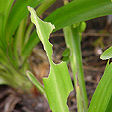
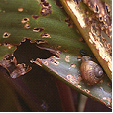
Susceptible Plants
A wide range of leafy plants, including ground crops, potatoes, tubers, leafy vegetables and seedlings.
Fern species are attacked causing serious damage. New fronds are repetitively eaten causing the plant to become stunted. Attacks are normally more severe during wet periods during which time control measures should be taken.
Morinda citrifolia is attacked by the Giant African Snail (Achatina fulica) which defoliates trees.
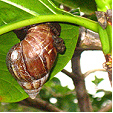

Cultural Control
Remove possible hiding places and avoid overhead watering to reduce humidity. Cultivate soil regularly; in commercial situations, allow the soil to remain fallow for one season to reduce numbers. Domestic infestations may be removed by hand. Traps may be created by inverting small pots near where snails and slugs are feeding; they will gather in these shelters during the day, and may be collected and destroyed. The popular Australian "beer trap" consists of a vertically-sided container, sunk into the ground and filled with beer, which intoxicates and drowns the snails.
Biological Control
Natural predators such as birds, frogs, and lizards reduce numbers, but do not provide effective control. Orchardists have used running ducks to control snails with some success.
Chemical Control
Commercial baits - molluscicides - made from methiocarb or metaldehyde are effective when used in combination with sanitation. Their effectiveness varies according to soil and weather conditions; it is generally recommended to avoid watering after application.
Note
Always read the label for registration details and direction of use prior to application of any chemicals.
Average Lowest Temperature : -5º C 23º F
USDA : 8, 9, 10, 11
This USDA (United States Department of Agriculture) hardiness zone chart can be used to indicate a plant’s ability to withstand average minimum temperatures. However, other factors such as soil type, pH, and moisture, drainage, humidity and exposure to sun and wind will also have a direct effect on your plant’s survival. Use this chart only as a guide, always keep the other factors in mind when deciding where, when and what to plant.
A plant's individual USDA zone can be found in the Plant Overview.
Region of origin
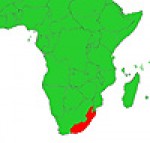
South Africa (Eastern Cape, KwaZulu-Natal)
Climate Description
Cool Temperate
This zone has low winter temperatures and moderate summer temperatures with low humidity and cool nights. Frosts are severe with snow at higher altitudes.
Drought rarely occurs and wind is cold inland or wet on the coast.
Plant growth
Cool weather plants grow well.
| Dictionary | Growth Habit |
| Leaf Type | Botanic Flower Description |
| Leaf Shape | Flower Inflorescence |
| Leaf Arrangement | Fruit Type |
| Leaf Margin | Bark Type |
| Leaf Apex And Bases | Flower Description |